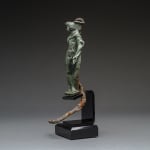Roman Bronze Figurine of Apollo, 100 CE - 300 CE
Bronze
height 15.2 cm
height 6 in
height 6 in
LK.116
Further images
It is not unusual to see Apollo depicted in such a dramatic contraposto pose, as if he has been caught mid-movement. This small figurine is finely and delicately moulded, showing...
It is not unusual to see Apollo depicted in such a dramatic contraposto pose, as if he has been caught mid-movement. This small figurine is finely and delicately moulded, showing the advantages of bronze sculpture over marble for the production of such small figures; the sculptor would begin by creating the figure from carving wax, thus allowing for a greater attention to detail. Here the god’s face is contorted into an expression of alarm, as is also suggested by his sudden turning back and with his arm raised to his head. It could be that this figurine was part of a set depicting a scene from a myth. His cloak is draped around his neck showing off his heroic, muscular physique. In his left hand he holds a laurel branch, one of his many attributes.
The purpose of such a figurine was likely to have been for private domestic worship, where libations would be poured before him with prayers being offered to invoke his guidance or to give thanks.
The purpose of such a figurine was likely to have been for private domestic worship, where libations would be poured before him with prayers being offered to invoke his guidance or to give thanks.





